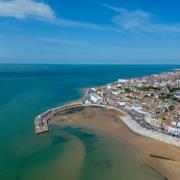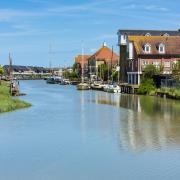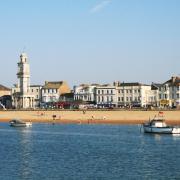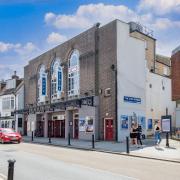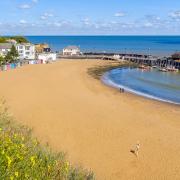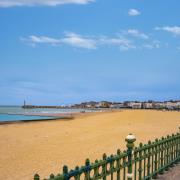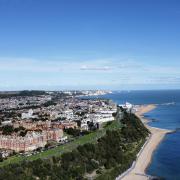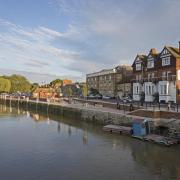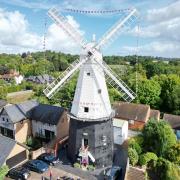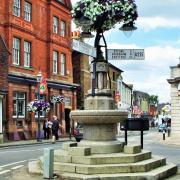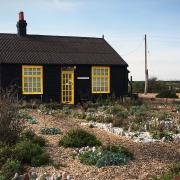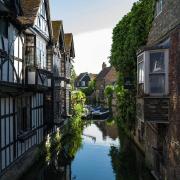There’s more to Rochester than its historic past, with a new train station and riverside regeneration keeping it bang up to date

Rochester oozes history at every turn, from the ancient landmarks which dominate its skyline to the cobbled streets and terraces of Georgian and Victorian houses. Like Canterbury, it is a real tourist destination and people come from all over the world to visit it, particularly during its popular annual festivals.
Among the big attractions are of Rochester Castle, which is always popular with young families and offers fabulous views from the top of the keep, and opposite, Rochester Cathedral.
This summer the cathedral will be unveiling its new exhibition space in the crypt and visitors will be able to view its original copy of the Textus Roffensis, a 12th-century legal encyclopaedia thought to be more important than Magna Carta.
Another draw remains Charles Dickens, who loved Medway and set several stories in Rochester. Literary-minded visitors can seek out places including College Gate, immortalised as Jasper’s gate house in The Mystery of Edwin Drood, and Restoration House, which becomes the decrepit mansion of Miss Havisham in Great Expectations.

The Guildhall Museum features the Dickens’ Discovery Rooms exhibition while Eastgate House, which he used for inspiration in both The Pickwick Papers and The Mystery of Edwin Drood, is undergoing a lengthy refurbishment and will re-open early next year as a heritage centre with space for cultural activities and events.
But while it’s impossible to forget its important past, Rochester has become a very 21st-century place to live, work and visit. Trendy boutiques and coffee shops have replaced some of the traditional old shops and the chintzy tea rooms, and the place has an arty, cutting-edge feel.
In December the town also welcomed a new £26m train station. With a new building in a more central position and a longer platform, the station is now able to offer extra trains to London. The riverside area, which is the subject of a massive upcoming regeneration scheme, has been linked directly to the station via a subway.

Eating and shopping
New, interesting places to eat and drink are popping up, complementing proven favourites such as Topes (01634 845270), Don Vincenzo (01634 408373), Elizabeth’s (01634 843472) and Brettington’s restaurants (01634 400192). Flourishing cafés, tea rooms and coffee shops include Mrs Tickit’s Pantry, Tiny Tim’s, Fleur de Thé and The Deaf Cat, as well as newcomers Crepe & Co pancake parlour, The Seaplane Works café and The Flippin’ Frog micropub.
And do browse around Francis Iles art shop and gallery, Fieldstaff Antiques, The Candy Bar, Rocket, Baggins Book Bazaar, Kiss Kiss Heart, Copenhagen Blue, the Demelza Boutique and wonderful little vintage store The Hendersons.

Property market
Rochester used to be one of Kent’s little secrets but the new developments, better rail links and more desirable High Street have had an effect on property prices, with an increase of an average of 20 per cent on asking prices over the last year. Two-bedroom terraced homes are currently priced at between £180,000 and £220,000, with three-bed semis on for between £230,000 and £350,000. At the top end of the scale, there are detached five and six-bed properties priced up to £800,000 and at the bottom end, a one-bedroom flat will cost around £150,000. Being on the river, there are a number of houseboats on the market. New developments include The Kings Quarter in Rochester and Templars Rise in Strood.
Diary dates

30 April-2 May: Sweeps Festival. The annual May Day celebrations will include Morris dancing, folk music on open-air stages, art stalls, an artisan produce fair and fun family activities.
3-5 June: Dickens Festival. Each year Rochester marks its close ties with the work of Charles Dickens with a weekend of costumed character parades, street entertainment, readings and lots of free activities. This year’s theme will be The Old Curiosity Shop.
13-16 July: Castle Concerts. Set in the spectacular setting of Rochester Castle gardens, this popular series of concerts take place each summer and attract some of music’s biggest names.
3-4 December: Dickensian Christmas Festival. It’s a long way off but Christmas is Rochester’s busiest time, thanks to the incredibly popular Dickens-themed Christmas Festival.
Meet the Huguenots
Director Emily Fuggle tells Kent Life about Rochester’s new Huguenot Museum
Who were the Huguenots?
The Huguenots were French Protestants living in a Catholic country. Over three centuries they struggled to practice their religion. By 1685 Huguenots in France had to give up their faith, hide their religion or escape. Around 60,000 Huguenots made the dangerous journey to Britain for a new life; our first refugees.
They brought with them skills in crafts such as silk weaving and silversmithing, they set up churches, schools and even a Hospital to support their fellow new arrivals.
The French Hospital was established in 1718 in London to provide care for elderly and infirm Huguenots and their descendants.
In 1959 the hospital needed to relocate and the Bishop of Rochester suggested a new home in the Georgian square on Rochester High Street, now called La Providence. Kent’s long connections with the Huguenots at Canterbury, Faversham and Sandwich meant that Rochester was seen as an appropriate new home. There are now 60 flats in the French Hospital, all almshouses for people of Huguenot descent.
Tell us about the museum
The Huguenot Museum first opened to the public in May last year following a major £1.2m development project. New galleries display objects never before seen by the public from the Hospital’s collection, including paintings, church silver and objects and papers belonging to Huguenot families across three centuries.
A vibrant learning space plays host to craft workshops, talks and film screenings. Our archive room offers a space to study the collections or investigate your family history.
What are some of the highlights?
Highlights include the wonderful paintings of Huguenots through the ages. We have a painting of Peter and Clara le Heup, who were married in 1722 and lived together in London. We also have a bible that was baked into a loaf of bread to hide it from French soldiers intent on terrorising a Protestant family. Until 18 June we will have a small display looking at silk made in Canterbury, the largest Huguenot settlement outside London. A highlight will be a dress woven there in 1724. A dress from Alexander McQueen’s latest collection by will also be displayed because Huguenot silk weavers inspired the house’s latest collection.
Kevan Middleton
Tell us a bit about you
I’m Kevan Middleton, owner of The Deaf Cat coffee bar. It’s been open for six and a half years and we’re still growing. I’d worked in London for almost 20 years in the creative and design industries and wanted to set up and run a business using everything I had learnt up to that point, plus lots of new challenges. I’m looking to open my second shop as soon as I find a good location.
What does the name refer to?
Charles Dickens had lots of cats in the house. I’m not sure if he had much choice in the matter, but one he was fond of used to sit on his desk while he was writing and play with the candle at night. Mr Dickens liked this. It turns out the cat was deaf. I like that the cat had no real name and that it used to inspire him, in the same way I hope my coffee shop inspires people.
What makes it unique?
We serve high-quality coffees (Origin) and tea (Teapigs). Our baristas are well trained and use great machinery, nothing is automated. I have concentrated on creating a space that is inspirational to my customers. The room has an earthy, mechanical, functional freedom, and the staff are free to show their personalities. There are no pretentions, everything is on show: nuts, bolts, wood grain, hinges and brackets. I like the honesty of that approach. We have a great collection of coffee pots from around the world.
How has Rochester changed in recent years?
When I first opened The Deaf Cat there were no other coffee shops, just tea rooms. Now there’s a Costa Coffee (and I appreciate their hard work in developing the coffee culture) and various other decent coffee shops.
There are definitely many more places to eat and drink, there’s also a new £26m train station and many more opportunities for art and culture, all of which is great for visitors.
What do you love about it?
There are two Dickens’ Festivals and the Sweeps Festival in May. The castle is amazing, the cathedral is beautiful and the museum is great.
There are buildings related to Charles Dickens everywhere, lots of good pubs and restaurants, and great views of the River Medway and its boats and birds. The Visitor Centre a few doors down from The Deaf Cat has all the information you could ask for and is well worth a visit.
The Deaf Cat is at 83, High Street, Rochester ME1 1LX. www.thedeafcat.com




